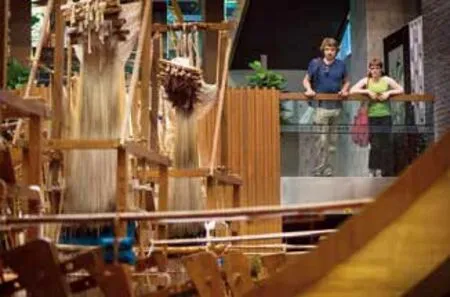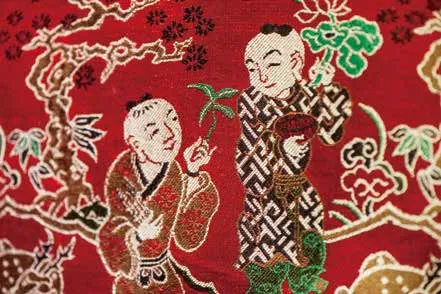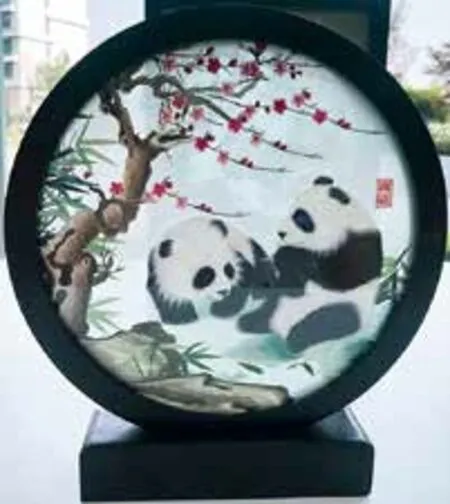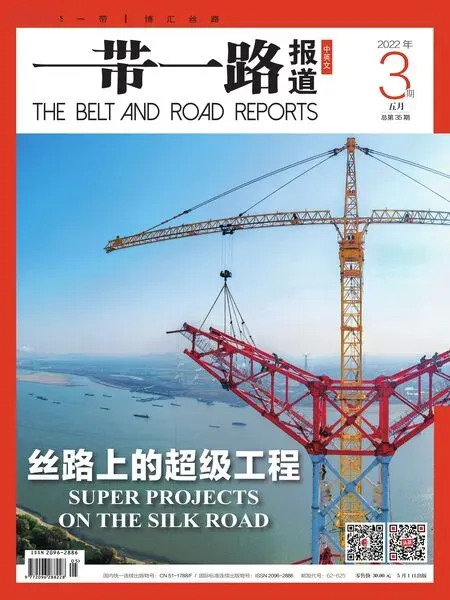非遗之“锦”“绣”漫谈——对话四川工艺美术大师赵敏
文:《一带一路报道》全媒体记者 贾琪


清代蜀锦织品——“方方”Shu Brocade of Qing Dynasty — “Fang Fang”
九天开出一成都,万户千门入画图。
在如画般美丽的锦官城,遍布着近300 项非物质文化遗产,它们犹如姹紫嫣红的花朵,竞相绽放,使得这片土地愈发熠熠生辉、光彩夺目。
在成都众多非遗中,蜀锦、蜀绣可谓是两朵“金花”,历经千年时光流转依旧璀璨夺目。近年来,伴随国潮崛起,蜀锦、蜀绣,以其轻柔雅致的质感、明丽清秀的色彩和精湛细腻的纹样和针法,向世人展示着精妙绝伦的“东方美”与“技艺美”蜚声海内外。
如今的蜀锦、蜀绣发展现状如何?二者之间有何联系,以其为代表的成都非遗如何融入并推动世界文明互鉴,传统非遗又如何进行传承与创新……带着这些问题,《一带一路报道》记者与四川省工艺美术大师、成都市非遗保护专家库专家、四川大学轻纺学院副教授赵敏进行了一次面对面的交流与沟通。
“丝绸之路”以“丝绸”来命名,毫无疑问,这是一条以丝绸为主要流通物品的贸易大通道。成都作为古代中国丝绸织品的主要原产地,早在三星堆文明时期,生产的丝绸就通过缅甸、印度传到中亚、西亚以至地中海地区,这条国际贸易线路便是著名的“南方丝绸之路”。汉代及以后从“北方丝绸之路”输往西方的中国丝绸中,也以四川丝绸为大宗。从“草原丝绸之路”输往北亚的中国丝织品中,目前所见年代最早的也是四川丝绸……历史证明,成都是丝绸之路的源头所在地之一。
西方社会对中国的丝绸一直十分青睐,最著名的例子就是罗马帝国的创立者凯撒大帝非常喜欢中国丝绸,甚至不顾罗马元老院对他“太过奢侈”的批评,依然穿着中国丝绸做成的袍子去剧场看戏。当时,由于他身穿的长袍太过绚丽夺目,在场的观众无不对皇帝的新装赞不绝口。此后,中国丝绸便在欧洲各国声名远扬,用中国丝绸制作的衣服成了最时髦、最讲究的服装。
中国的丝绸文明主要是向外输出,比如伴随着公主和亲以及商业行为在海外进行技术传播与文化传播。同时,这种传播又是双向的。“丝绸之路”见证了东西方文明的交融,从中国的纺织纹样变化来讲,我们的很多纹样,如回纹、宝象花纹就出自西方的佛教文化。又比如我们使用的织机,也与西方有着密切联系。在这种你来我往、互相借鉴、取长补短的互动中,东西方文明相互促进、相互影响。
另外,古代成都不仅是“丝绸之路”上重要的商贸中心、交通枢纽,也是重要的文化中心。丝绸文明传播的同时,中西方其他产品和文化也在“丝绸之路”上相互流通。比如三星堆遗址出土的海贝、象牙等文物,经研究就来自海外。

外国游客参观传统蜀锦纺织机器——小花楼织器Foreign tourists visit the Xiaohualou Weaving Machine, a traditional Shu brocade textile machine(本版图片/新华社 供图)
成都蜀锦与南京云锦、苏州宋锦、广西壮锦并称中国四大名锦。蜀绣与苏绣、湘绣、粤绣齐名,为中国四大名绣之一。两者历史悠久,并称“蜀中瑰宝”。
作为非遗代表的蜀锦、蜀绣,从材料上来说,蜀锦的主要材料是蚕丝,整体感觉柔软顺滑,适合与肌肤接触。蜀绣则没有主次,用料杂多,绣布包含棉、麻、缎等,整体不如蜀锦轻柔顺滑;从工具上来说,蜀锦靠“织”,生产主要工具是织机。蜀绣靠“绣”,主要使用绣针和绷子;从技艺上来说,蜀锦是以丝线纵横交错构成经纬线,然后再用彩色丝线通过机器操作完成穿梭织绘。蜀绣则是靠双手操作针线,在绣布上游走而完成作品。
伴随着国潮崛起,蜀锦、蜀绣等非遗技艺和产品正被越来越多人熟知,蜀锦、蜀绣在四川成产业规模发展,成都拥有全国最大的蜀锦织绣企业蜀江锦院,是外地游客及青少年体验和研学的去处之一。随着科技进步,蜀锦、蜀绣在织造过程中加大了对现代机器的使用,其与AI 等新技术相结合,打造成都特色汉服标志,借助直播、网店销售等营销手段,创新发展。
现在,蜀锦、蜀绣的发展主要面临两个方面的问题。一个是传承问题,虽然有政策扶持,但真正掌握核心技术的高精尖人才比较稀缺。需要通过大师带教和开展培训班,培养真正热爱蜀锦、蜀绣的年轻人才,使技术得以传承。另一个是市场问题。传统蜀锦、蜀绣需纯手工制作,周期长、面料贵、成本高,一般消费者可望不可及。需要以文化培育市场,只有源源不断的市场需求,才能助力非遗真正传承下去。
文明交流互鉴是推动人类文明进步和世界和平发展的重要动力。“一带一路”建设为非遗提供了文化支撑,大量的非遗产品走出国门,文物为媒,讲述四川故事和中国故事,弘扬丝路精神,架起中国与世界人民沟通的文化桥梁。
“一带一路”建设为非遗的发展提供了更大的机遇,非遗在“走出去”的过程中,既要打造更多的优秀原创作品,更要注意寻求能与沿线人民产生共鸣的人物故事和文化元素。同时,建议非遗用好已经搭建或正在搭建的各种国际交往平台,进一步提升国际“朋友圈”的关注度。
Created by God, every household in Chengdu has a beautiful view.
The picturesque city of Chengdu boasts nearly 300 items of intangible cultural heritage, which, like flowers, in turn endow this land with splendor.
Among the many, Shu brocade and Shu embroidery can be described as two “golden flowers” that have been passed down for thousands of years. In recent years, with the rise of the Chinese style fashion trend, Shu brocade and Shu embroidery have once again become reputed at home and abroad. They present to the world the “aesthetics of the East” and the“aesthetics of techniques” with their elegant texture, bright and beautiful colors, and exquisite patterns and needlework.
What is the current status of Shu brocade and Shu embroidery? What is the connection between the two? How does the intangible cultural heritage in Chengdu with the two as the most prominent integrate into and promote mutual learning among world civilizations? How to pass on and innovate traditional intangible cultural heritage … With these questions in mind, we had a face-to-face exchange with Zhao Min, a master of arts and crafts in Sichuan Province, an expert in the intangible cultural heritage protection expert database in Chengdu, and an associate professor at the College of Biomass Science and Engineering of Sichuan University.
Reporter: “”?
“Silk Road” is named after “silk”. There is no doubt that it is a major trade channel with silk as the main circulated item. Chengdu was the main provenance of silk fabrics in ancient China. In the period of Sanxingdui civilization, the silk produced in Chengdu was spread to Central Asia, West Asia and the Mediterranean region through Myanmar and India. This international trade route is the famous “Southern Silk Road”. The silk products from Sichuan were bulk commodities among those delivered from China to the West via the “Northern Silk Road”in the Han Dynasty and later periods. Among those exported to North Asia via the “Prairie Silk Road”, silk products of Sichuan were the earliest we have seen so far … According to historical evidence, Chengdu is one of the origins of the Silk Road.
Reporter: ??
The Western society has always favored Chinese silk. To list the most famous example, Julius Caesar, founder of the Roman Empire, liked Chinese silk very much and went to the theater in robe made of Chinese silk despite that the Roman Senate complained about him being “too extravagant”. The robe was too gorgeous and amazed all the audience. Then Chinese silk had become well-known in European countries, and the clothes made of Chinese silk the most fashionable.
China's silk civilization served as an export. It was spread in terms of techniques and culture as princesses were married to rulers of minority nationalities in the border areas for making peace and business behaviors were carried out.The spread was bidirectional. The “Silk Road” witnessed the fusion of Eastern and Western civilizations. Many of the Chinese textile patterns, such as the fret and rosette designs, came from the Western Buddhist culture. The loom we use was also from the West. Thanks to the interaction with the two sides learning from each other to make the best of them,Eastern and Western civilizations promote and influence each other.
In addition, the ancient Chengdu was not only an important commercial and trade center and transportation hub on the “Silk Road”, but also an important cultural center. While the silk civilization spread, other products and cultures from China and the West were circulated on the“Silk Road”. For example, the seashells,ivory and other cultural relics unearthed from the Sanxingdui site came from overseas according to the research.
Reporter: ,.?
Shu brocade from Chengdu, Yun brocade from Nanjing,Song brocade from Suzhou and Zhuang brocade from Guangxi are known as the “Four Famous Kinds of Brocade in China”. Shu embroidery is as famous as Suzhou embroidery, Hunan embroidery and Guangdong embroidery, and is one of the four famous kinds of embroidery in China. The two enjoy a long history and are called “Treasures of Shu”.
Shu brocade and Shu embroidery indicate the outstanding skills of silk production. In terms of material, Shu brocade is mainly made of silk, and feels soft, smooth, and skin-friendly.Shu embroidery resorts to many kinds of materials as it is made of cotton, linen, silk, etc. It is not as soft and smooth as Shu brocade. In terms of tools, Shu brocade relies on loom or“weaving”. Shu embroidery relies on needlework with needle and tambour. Technically, for Shu brocade, silk threads are crossed to form the base, and then colored silk threads woven through with the loom. Shu embroidery resorts to hands that lead the needle and thread through the cloth.

清代蜀锦织品——“百子图”局部细节Shu Brocade work of Qing Dynasty — Local details of “One Hundred Children”(新华社 供图)
Reporter: ??
With the rise of the Chinese style fashion trend,Shu brocade, Shu embroidery and other intangible cultural heritage techniques and products are becoming increasingly familiar to people. They have developed into large-scale industries in Sichuan. Chengdu has the largest Shu brocade weaving enterprise in China, Shujiang Jinyuan, which has long been one of the destinations for foreign tourists and teenagers for experience and study. With the scientific and technological progress, the use of modern machines has been increased in the weaving process for Shu brocade and Shu embroidery.New technologies such as AI have been employed to create the logo for Han clothing specific to Chengdu.Live streaming, online stores and other marketing all function to promote the innovation and development.
Shu brocade and Shu embroidery are now faced with two problems. First, there are few highly talented professionals, a long production cycle, high prices of materials and high costs, which make it out of reach of ordinary consumers. The second problem is about how it can be passed down. The techniques can be passed down with policy support and training courses taught by masters, and it has driven forward rural revitalization. They are not enough, however. The core should lie in cultural inheritance, which is to cultivate the market with culture. The intangible cultural heritage can be passed down only by dint of a constant market demand.

蜀绣作品 《大熊猫》Shu Embroidery work“Giant Panda”(雷露 摄)
Reporter: ?
The exchange and mutual learning between civilizations is an important driving force for the progress of human civilization and the peaceful development of the world. The Belt and Road construction provides cultural support for intangible cultural heritage.A large number of intangible cultural heritage products have gone abroad, and cultural relics serve as the medium to tell the stories of Sichuan and China, carry forward the Silk Road spirit, and build a cultural bridge between China and the outside world.
The Belt and Road construction provides greater opportunities and broader space for the development of intangible cultural heritage. As intangible cultural heritage goes out, more excellent original works should be created, and,more important, figures, stories and cultural elements found to arouse sympathy with peoples residing along the Belt and Road. Also, various international communication platforms that have been built or are being built should be made good use of for intangible cultural heritage,so as to arrest more attention from the international community.

